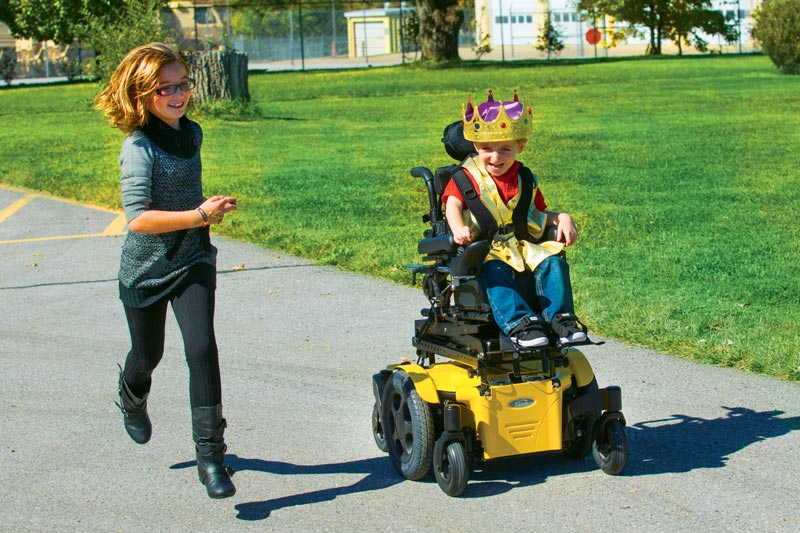Exercise is an important part of maintaining a healthy lifestyle and is incredibly beneficial to physical and mental well-being. Sometimes, children with disabilities find certain types of exercise difficult or disability-exclusive, but there are options that make physical activity accessible (and fun) for children of all ages and abilities. With the help of adaptive sports and activities, children with disabilities can be included in exercise and can reap the social, emotional, and physiological rewards of an active lifestyle.
Heart, Lungs, and Weight Management
Obesity and overweight are growing problems in the United States, the United Kingdom, and Australia. Children who are overweight are often at a higher risk of developing associated illnesses and diseases, and they are more likely to experience obesity as adults. When children with disabilities are introduced to exercise and sports at a young age, they are able to develop strong, healthy exercise habits. This can help them to maintain a healthy weight as they grow into adulthood, and it can also be hugely beneficial to their cardiovascular and respiratory health.
Muscular and Skeletal
Regular exercise helps children of all abilities to develop strong muscles, bones, and coordination skills, reducing the risk of osteoporosis, arthritis, and other musculoskeletal conditions. Children with disabilities may initially struggle with sports and activities that put strain on their muscles or bones, but there are many forms of exercise – for instance, swimming or water aerobics – that demand lower physical endurance while still providing the benefits of exercise. For children who experience joint swelling and associated pain, careful, medically-guided exercise programs can be helpful in reducing inflammation and managing some symptoms.
Mental and Social Wellbeing
Physical activity is an important factor in regulating mental and emotional well-being. Children who exercise regularly are often better able to focus at school and have improved cognitive function. Exercise triggers the release of feel-good endorphins, like serotonin, in the brain. This can help to reduce stress and lower the risk of depression and anxiety. Additionally, exercise is a wonderful opportunity for children with disabilities to build social connections. By engaging with other children in an athletic capacity, children can develop strong friendships, which is helpful in improving confidence and reducing feelings of loneliness and social isolation.
Barriers to Exercise for Children with Disabilities
Risk and liability concerns, perceived incapabilities, lack of necessary equipment or support, high costs, and under-educated programmers can all be barriers to exercise for children with disabilities. However, there are some activity providers that specialize in adapted exercise programming, and many schools and doctors are able to help with the formation of a healthy exercise routine.

Types of Exercise
Swimming and Water Aerobics
Swimming and other water-based activities can be a brilliant way of introducing exercise to children who experience difficulties with physical mobility. Water buoyancy can help to reduce mobility barriers, enabling children with disabilities to engage in activities that work to improve their musculoskeletal and cardiovascular strength. There are many options when it comes to water sports. Children can swim, take part in water aerobics, or seek hydrotherapy treatment, which utilizes warm water pools in a therapeutic setting.
Horseback Riding
Horseback riding is often a fan favorite among children, and it's fantastic for improving core stability, balance, and posture. Engaging muscles, motor planning, reflexes, and coordination, horse riding can be a great option for children who require muscular exercise or rehabilitation. Beyond the mental and social benefits of mainstream exercise, horseback riding includes contact with animals, which many children enjoy.
Wheelchair Basketball, Rugby, Soccer
Basketball, rugby, and football enable children to become part of a sporting team, which can have a number of positive social and emotional effects. With minor adaptations, these sports can be great options for children with many different kinds of disabilities. Wheelchair basketball, rugby, and soccer clubs offer inclusive environments where children can get active and share a love of sport with their peers.
Wheelchair Tennis
Tennis is an incredibly popular sport and a fantastic adaptable activity. There are a number of wheelchair tennis programs available around the country, along with programs for children who live with Autism or intellectual disabilities.
Wii Sports
Children who are fans of video games are often enthusiastic when exercise can incorporate tech games. Wii Sports games can help children to take part in physical activities that may otherwise be inaccessible to them. Easily set up in a child's home, Wii Sports are adaptable, self-guided, and inclusive. Children's grip can be assisted by the controller strap, and mobility requirements can be accounted for. Wii Sports games can serve as an introduction to athletic participation, which can later be transferred to non-digital sports.
Yoga or Tai Chi
Yoga has become a popular exercise choice for both children and adults who live with disabilities. Yoga is incredible adaptable and can be individually tailored as needed. Level of participation can be self-led and flexible. Yoga can help to improve muscle and core strength, bodily control and awareness, and relaxation. Similarly, tai chi can be a brilliant option for children who struggle with fast-paced exercise activities. Tai chi is a slow, controlled form of physical exercise that works on individual muscle groups.
Exercise is essential to overall well-being. For more information on exercise options and support services for children with disabilities, visit Action for Healthy Kids.
Most of the stories here on LiveQuickie.com were submitted by readers. Do you have a story to tell? We'd love to hear it. Submit your story here.